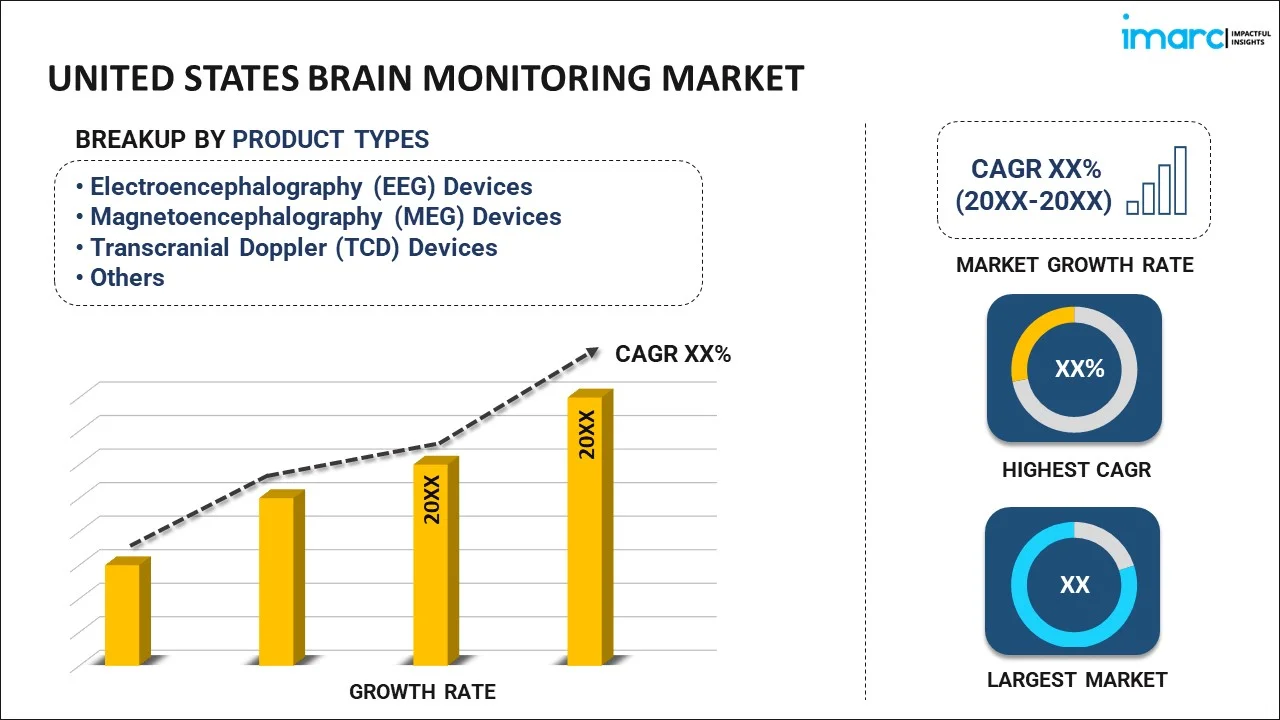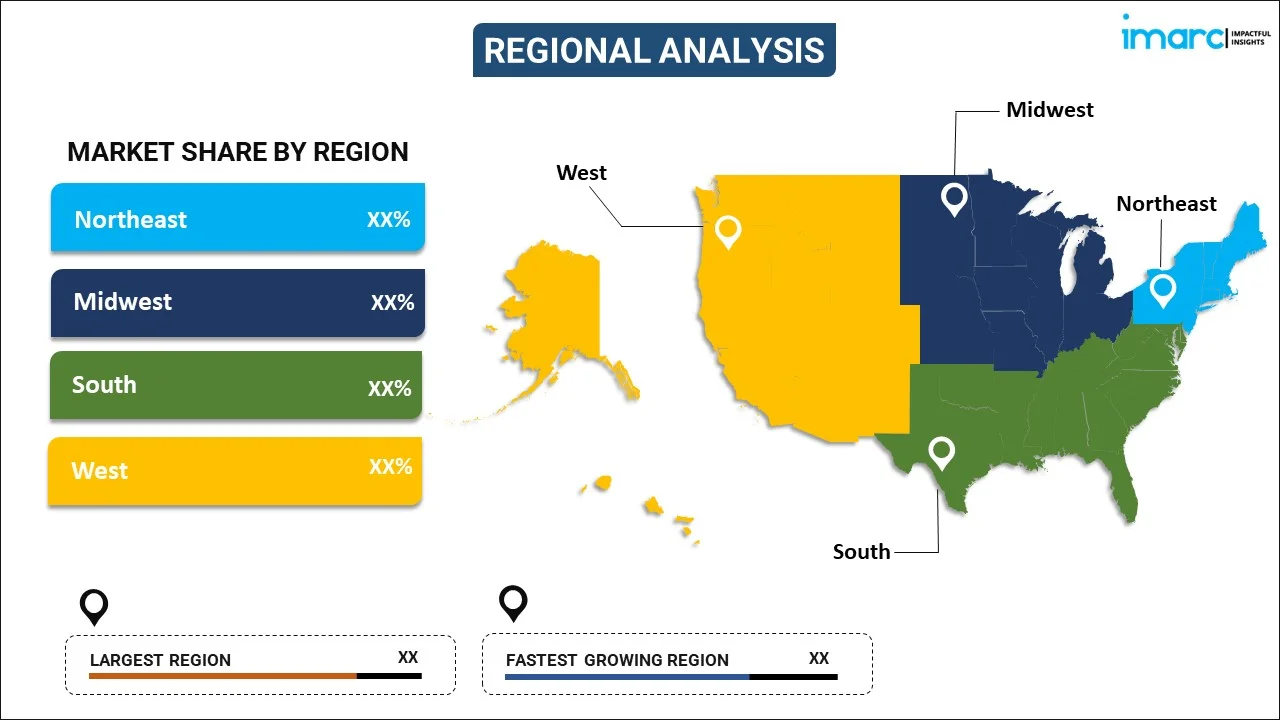
United States Brain Monitoring Market Report by Product Type (Electroencephalography (EEG) Devices, Magnetoencephalography (MEG) Devices, Transcranial Doppler (TCD) Devices, Intracranial Pressure (ICP) Monitors, Cerebral Oximeters, Magnetic Resonance Imaging (MRI) Devices, Computerized Tomography (CT) Devices, Positron Emission Tomography (PET) Devices, Sleep Monitoring Devices, Electromyography (EMG) Devices, Accessories), Procedure (Invasive, Non-invasive), Application (Parkinson’s Disease, Traumatic Brain Injury (TBI), Epilepsy, Dementia, Sleep Disorders, and Others), End User (Hospitals, Diagnostic Centers), and Region 2024-2032
Market Overview:
United States brain monitoring market size reached US$ 1.6 Billion in 2023. Looking forward, IMARC Group expects the market to reach US$ 2.8 Billion by 2032, exhibiting a growth rate (CAGR) of 6.45% during 2024-2032. The increasing prevalence of neurological disorders, such as epilepsy, Alzheimer's disease, Parkinson's disease, and stroke, which has enhance the demand for brain monitoring technologies, is driving the market.
|
Report Attribute
|
Key Statistics
|
|---|---|
|
Base Year
|
2023 |
|
Forecast Years
|
2024-2032 |
|
Historical Years
|
2018-2023
|
| Market Size in 2023 | US$ 1.6 Billion |
| Market Forecast in 2032 | US$ 2.8 Billion |
| Market Growth Rate (2024-2032) | 6.45% |
Brain monitoring refers to the continuous observation and measurement of brain activity, providing valuable insights into neurological functions. Various techniques are employed to monitor the brain, including electroencephalography (EEG), functional magnetic resonance imaging (fMRI), and magnetoencephalography (MEG). EEG records electrical activity through electrodes on the scalp, offering real-time data on brain waves and patterns. fMRI measures blood flow changes in the brain, highlighting areas of neural activity. MEG detects magnetic fields generated by neuronal activity. These monitoring methods are crucial in diagnosing and managing neurological disorders, studying cognitive processes, and assessing the impact of interventions. Additionally, advancements in brain monitoring technologies contribute to understanding brain function, enhancing neuroscientific research, and improving medical treatments for conditions such as epilepsy, sleep disorders, and traumatic brain injuries.
United States Brain Monitoring Market Trends:
The brain monitoring market in the United States is experiencing robust growth, propelled by a confluence of factors. Firstly, advancements in technology have revolutionized the landscape, with cutting-edge innovations enabling more precise and non-invasive monitoring of brain activity. Additionally, the increasing prevalence of neurological disorders and the growing awareness of the importance of early detection and monitoring have created a substantial demand for brain monitoring solutions. Moreover, the integration of artificial intelligence and machine learning algorithms into monitoring devices has significantly enhanced their diagnostic capabilities, allowing for more accurate and timely assessments. Furthermore, rising investments in R&D by key market players have fueled the development of novel monitoring techniques and devices, expanding the market's scope and potential. Connectively, the burgeoning geriatric population, prone to age-related neurological conditions, has contributed to the escalating demand for brain monitoring solutions. The synergistic effect of these drivers has created a conducive environment for market expansion, fostering collaborations between healthcare providers, technology developers, and research institutions. In conclusion, the brain monitoring market in the United States is poised for sustained growth, driven by a nexus of technological innovation, heightened awareness, and an aging population's increasing healthcare needs.
United States Brain Monitoring Market Segmentation:
IMARC Group provides an analysis of the key trends in each segment of the market, along with forecasts at the country level for 2024-2032. Our report has categorized the market based on product type, procedure, application, and end user.
Product Type Insights:

- Electroencephalography (EEG) Devices
- Magnetoencephalography (MEG) Devices
- Transcranial Doppler (TCD) Devices
- Intracranial Pressure (ICP) Monitors
- Cerebral Oximeters
- Magnetic Resonance Imaging (MRI) Devices
- Computerized Tomography (CT) Devices
- Positron Emission Tomography (PET) Devices
- Sleep Monitoring Devices
- Electromyography (EMG) Devices
- Accessories
The report has provided a detailed breakup and analysis of the market based on the product type. This includes electroencephalography (EEG) devices, magnetoencephalography (MEG) devices, transcranial doppler (TCD) devices, intracranial pressure (ICP) monitors, cerebral oximeters, magnetic resonance imaging (MRI) devices, computerized tomography (CT) devices, positron emission tomography (PET) devices, sleep monitoring devices, electromyography (EMG) devices, and accessories.
Procedure Insights:
- Invasive
- Non-invasive
A detailed breakup and analysis of the market based on the procedure have also been provided in the report. This includes invasive and non-invasive
Application Insights:
- Parkinson’s Disease
- Traumatic Brain Injury (TBI)
- Epilepsy
- Dementia
- Sleep Disorders
- Others
The report has provided a detailed breakup and analysis of the market based on the application. This includes parkinson’s disease, traumatic brain injury (TBI), epilepsy, dementia, sleep disorders, and others.
End User Insights:
- Hospitals
- Diagnostic Centers
A detailed breakup and analysis of the market based on the end user have also been provided in the report. This includes hospitals and diagnostic centers.
Regional Insights:

- Northeast
- Midwest
- South
- West
The report has also provided a comprehensive analysis of all the major regional markets, which include Northeast, Midwest, South, and West.
Competitive Landscape:
The market research report has also provided a comprehensive analysis of the competitive landscape. Competitive analysis such as market structure, key player positioning, top winning strategies, competitive dashboard, and company evaluation quadrant has been covered in the report. Also, detailed profiles of all major companies have been provided.
United States Brain Monitoring Market Report Coverage:
| Report Features | Details |
|---|---|
| Base Year of the Analysis | 2023 |
| Historical Period | 2018-2023 |
| Forecast Period | 2024-2032 |
| Units | US$ Billion |
| Scope of the Report | Exploration of Historical and Forecast Trends, Industry Catalysts and Challenges, Segment-Wise Historical and Predictive Market Assessment:
|
| Product Types Covered | Electroencephalography (EEG) Devices, Magnetoencephalography (MEG) Devices, Transcranial Doppler (TCD) Devices, Intracranial Pressure (ICP) Monitors, Cerebral Oximeters, Magnetic Resonance Imaging (MRI) Devices, Computerized Tomography (CT) Devices, Positron Emission Tomography (PET) Devices, Sleep Monitoring Devices, Electromyography (EMG) Devices, Accessories |
| Procedures Covered | Invasive, Non-invasive |
| Applications Covered | Parkinson’s Disease, Traumatic Brain Injury (TBI), Epilepsy, Dementia, Sleep Disorders, Others |
| End Users Covered | Hospitals, Diagnostic Centers |
| Regions Covered | Northeast, Midwest, South, West |
| Customization Scope | 10% Free Customization |
| Report Price and Purchase Option | Single User License: US$ 3699 Five User License: US$ 4699 Corporate License: US$ 5699 |
| Post-Sale Analyst Support | 10-12 Weeks |
| Delivery Format | PDF and Excel through Email (We can also provide the editable version of the report in PPT/Word format on special request) |
Key Questions Answered in This Report:
- How has the United States brain monitoring market performed so far and how will it perform in the coming years?
- What has been the impact of COVID-19 on the United States brain monitoring market?
- What is the breakup of the United States brain monitoring market on the basis of product type?
- What is the breakup of the United States brain monitoring market on the basis of procedure?
- What is the breakup of the United States brain monitoring market on the basis of application?
- What is the breakup of the United States brain monitoring market on the basis of end user?
- What are the various stages in the value chain of the United States brain monitoring market?
- What are the key driving factors and challenges in the United States brain monitoring?
- What is the structure of the United States brain monitoring market and who are the key players?
- What is the degree of competition in the United States brain monitoring market?
Key Benefits for Stakeholders:
- IMARC’s industry report offers a comprehensive quantitative analysis of various market segments, historical and current market trends, market forecasts, and dynamics of the United States brain monitoring market from 2018-2032.
- The research report provides the latest information on the market drivers, challenges, and opportunities in the United States brain monitoring market.
- Porter's five forces analysis assist stakeholders in assessing the impact of new entrants, competitive rivalry, supplier power, buyer power, and the threat of substitution. It helps stakeholders to analyze the level of competition within the United States brain monitoring industry and its attractiveness.
- Competitive landscape allows stakeholders to understand their competitive environment and provides an insight into the current positions of key players in the market.
Need more help?
- Speak to our experienced analysts for insights on the current market scenarios.
- Include additional segments and countries to customize the report as per your requirement.
- Gain an unparalleled competitive advantage in your domain by understanding how to utilize the report and positively impacting your operations and revenue.
- For further assistance, please connect with our analysts.

 Inquire Before Buying
Inquire Before Buying
 Speak to an Analyst
Speak to an Analyst
 Request Brochure
Request Brochure
 Request Customization
Request Customization



.webp)




.webp)












